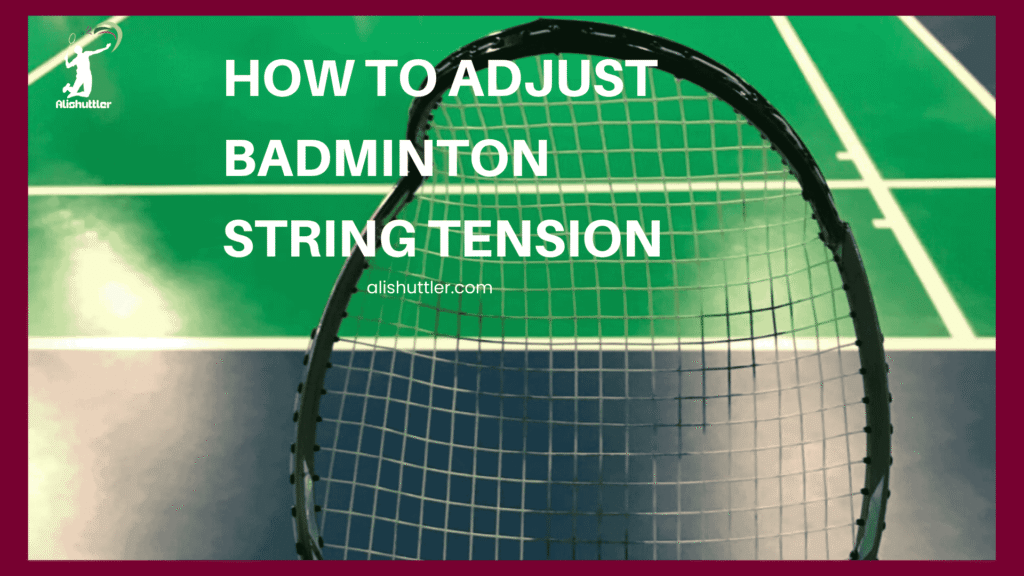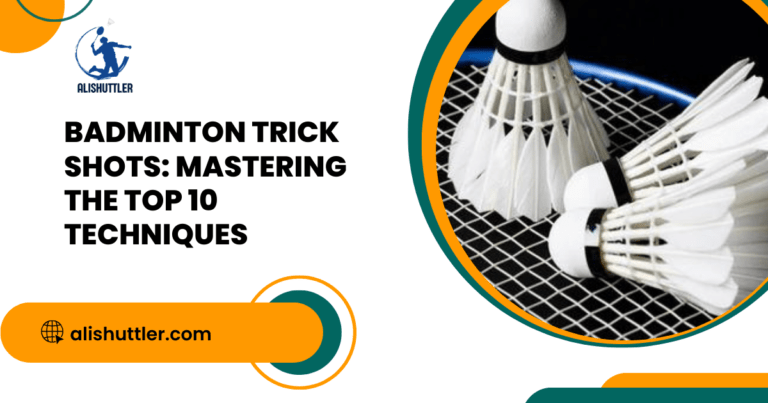To adjust badminton string tension, use a stringing machine or manual tools to change how tight or loose the strings are. String tension influences power, control, and feel while playing, so players tend to adjust tensions according to skill level or style of play.
Newbies might select lower tension for greater power, while experienced players might prefer higher tension for enhanced control. The body below details each step and provides tips for various requirements.
The Tension Dichotomy
Badminton string tension determines a racket’s feel and playability. The right Badminton String Tension can impact your power, control, and comfort on court, so it’s worth understanding what each range offers. This table delineates the distinctions between higher and lower string tension, employing typical ranges in kilograms for international clarity.
Here are the key trade-offs summarized in the table below.
| Tension Range | Power | Control | Comfort | Sweet Spot | Risk of Breakage | Sound |
|---|---|---|---|---|---|---|
| Lower (8–9 kg) | High | Low | Soft | Large | Low | Dull |
| Higher (10–13.5 kg) | Low | High | Firm | Small | High | Loud |
Higher Tension
Higher string tension, around 10–11 kg (22–24 lbs), provides increased control and more precise shot positioning. Among advanced players with quick swings, they like this setup because it enables them to place the shuttlecock exactly where ever they want.
The tight string bed means the shuttle sits on the strings for a shorter period, allowing easier placement of accurate drops or net shots. It’s not without sacrifices. Strings strung this tight? They’re more likely to break, particularly if you have off-center hits or play frequently.
To derive power from high tension, you require strong technique and quickness. Otherwise, the racket plays harsh and less forgiving. Fast, powerful swingers can really take advantage of this arrangement, while others may struggle to get the shuttle deep in court.
The infamous ‘trampoline effect’, in which the string bed flexes and catapults the shuttle, is diminished with higher tension. So, the racket sounds crisper but less bouncy.
Lower Tension
Lower tension around 8—9 kg (18—20 lbs) is easier for most beginners. The strings flex more, giving you a softer bed and bigger sweet spot. Which means more power with less effort, and off-center hits are less punishing.

The feel is comfortable, which can help prevent arm and wrist strain during those marathon games. Lower tension reduces rough vibrations. This can be a life-saver if you’re new or injury-prone, because it takes more of the impact.
On the negative side, you relinquish some control. The shuttle ‘dwell time’ is longer, making smashes and tight netshots harder. Still, for beginner players or those who like a mushier feel, this configuration adds up.
Personal Preferences
Some players prefer more control and crispness, while others favor a softer, more forgiving string bed. Technique, strength and style of play all sculpt what string tension feels optimal.
A good rule is to adjust Badminton String Tension by 0.5 kg (1 lb) increments until it feels right. Playing frequency and racket type matter. Tension can drop as much as 1.5 kg (3 lbs) in a week after restringing.
Notice how your racket feels and sounds as you play.
Finding Your Tension
Determining the optimal Badminton String Tension for your racket depends on multiple considerations. The most important factors include your level, style of play, and the type of badminton strings used, as these elements interact to help you make an informed decision and maximize your racket’s performance.
1. Skill Level
String tension should correspond with your experience. If you’re starting, low tension typically less than 23lbs (10kg) provides a bigger sweet spot. This not only simplifies shuttle strikes but decreases miscues and arm tension.
As you progress to intermediate, you may experiment with mid-range Badminton String Tension, approximately 24–27lbs (11–12kg), for a combination of power and control. Top players generally use higher tension, 28lbs (12kg) or more, for improved shuttle feedback and control.
It’s typical to adjust your Badminton String Tension as you get better, so your racket corresponds to your skills. For context, some use a rule: string Badminton String Tension should be about 10% less than your weight in kg. It’s only a guide, after all. Calibration is a matter of practice.
As you become acclimated to highBadminton String Tension, your playable window shrinks, so you’ll observe subtle differences more than casual players.
2. Playing Style
Your playing style factors into Badminton String Tension selection as well. If you play with a lot of smashes and fast drives, higher tension helps you harness your strength and keep shots snappy. Defensive players might prefer lower tension for easier clears and softer shots, as the shuttle bounces off the strings with less force.
Experimenting with various Badminton String Tensions is crucial. A rally-happy defender might prefer 22–24lbs (10–11kg). An attacking player might like 28lbs (12kg) or above. Your style will shift, so don’t be afraid to change and experiment with what feels right.
3. String Choice
String material and gauge count. Thinner strings (0.65–0.68mm) provide more bite and feel, perfect for high tension but can snap quicker. Thicker strings (0.70mm+) last longer and respond well to lower tension, however you may sacrifice a bit of touch.
Others use hybrid stringing, combining string types to achieve the combination of power and durability. String tension can fall 1–3lbs in a week post-restring. Some players string 2–3lbs higher than their desired tension to offset this drop.
Even with the same racket and string, Badminton String Tension can vary somewhat. Devices, like pitch-measuring apps, assist in checking, but results aren’t always precise.
4. Shuttlecock Type
Feather and plastic shuttlecocks respond differently. Since feather shuttles are lighter and fly faster, players prefer a tad higher Badminton String Tension for control. Plastic shuttles are heavier and slower; thus, lower Badminton String Tension aids in power and comfort.
If you swap shuttle types, experiment by adjusting your string Badminton String Tension 1–2lbs (0.5–1kg) to see what feels best. Testing as you go gets you used to new shuttles.
Tension Recommendations
Selecting the correct string tension is crucial in terms of comfort, control, and power in badminton. The best range for you varies with your proficiency level, racket type, and playing style. Tension affects how the shuttle exits your racket, how much power you receive and how much control.
Below is a quick list of recommended tension ranges based on skill level:
- Beginner: 17–20 lbs (7.7–9.1 kg)
- Intermediate: 20–24 lbs (9.1–10.9 kg)
- Advanced: 24–27 lbs (10.9–12.2 kg)
- Professional/International: 27–30+ lbs (12.2–13.6+ kg)
Consult your racket’s tension chart for an optimal range. Not every racket can withstand high tension. If you’re using plastic shuttles, reduce the tension by 1–2 lbs. For increased control, tension the cross strings 10% higher than the main strings.
Anticipate a 1–3 lb tension decline, the initial week post-restringing. Thinner strings over 24 lbs tend to snap more quickly. Most players prefer 24–28 lbs, but always consider your style and comfort.
Beginners
- Use 17–20 lbs tension for a forgiving string bed.
- Rely on your racket’s tension chart before stringing.
- Concentrate on skill-building and stroke technique first. Tension tweaks are a late thing.
- Comfort and control trump power at this point.
- Check tension once a month to keep strings responsive and prevent injury.
For novices, getting good fundamentals is more effective than hunting for the right string tension. A more flexible string bed, particularly with low tension strings, helps dampen shock and simplify the learning curve. If you play with plastic shuttles, consider lowering your badminton racket string tension for a snappier response.
Intermediates
Experiment with tension between 20–22 lbs to balance control and power. As your skills mature, minor shifts in tension can assist to hone your game. Evaluate your style, and determine whether more control or more power fits it.
You may find it worthwhile to experiment with different string types, as some provide a more grip/durability combination at specific tensions. Intermediate players frequently oscillate between natural and plastic shuttles.
If you experience rapid tension loss or string wear, opt for thicker strings for enhanced durability. Be sure to record your tension recommendations and string type.

Advanced Players
Expert players can employ 22–24 lbs tension for added control and speedy response. This range allows experienced golfers to craft shots with greater precision. Detailed tension tuning matters in competitive play, where every point counts.
Always take your style of play into consideration. Attack players can opt for the higher tension for fast smashes whereas defensive players can stay towards the lower end of the range for easier clears.
Check tension monthly and after every restring to maintain consistent performance.
Personal Preferences
Modify tension according to your play frequency and rate of skill development. Players on a few times a week schedule might require additional restringing. Your comfort should take priority, not population statistics.
Check your needs every season. If your game style shifts, adapt tension accordingly. Let match feedback help you find the tension that feels right.
Tension is personal—no single range fits all.
The Unseen Factors
String tension, particularly badminton racket string tension, is more than just a technical parameter—it’s influenced by factors that may not be immediately apparent. Your racket string tension can vary with playing conditions, your badminton racket, and the type of feel you desire on court, significantly impacting your play.
Environment
Temperature and humidity can shift string tension over time. If you play in a steamy, humid environment, your strings can lose tension rapidly–1-3 lbs. In a single week, even with a great stringing job. In cold or dry areas, strings tend to be stiffer and tauter, altering the manner in which the shuttle exits the string bed.
It assists in storing rackets in a climate-controlled location, not a hot car or a humid basement, if you want the tension to remain consistent. Playing indoors or outdoors counts – indoor courts tend to have more consistent conditions, whereas outdoor play adds swings in weather, so you might consider adjusting your tension prior to venturing outside.
Be mindful of how your strings respond once you change locations or the weather changes – a minor alteration can go a long way in your power and control.
Racket Frame
Not all badminton rackets respond similarly with every racket string tension. A stiff frame can absorb and maintain greater tension, which aids in control, but it reduces the sweet spot, rendering off-center strikes less forgiving and increasing the likelihood of string breakage. Flexible frames are gentler on your arm and can be strung a bit looser, which can assist if you’re still learning or if you get shoulder pain frequently.
For beginners, using thick strings is advisable as they are more durable and have a better tolerance for miss-hits, while thin strings snap more easily. Certain rackets have a sweet spot for tension, typically listed as a range of 20-27 lbs. Trying various badminton strings with different tensions is a good way to discover the fit for you.
If you are using plastic shuttlecocks, the usual tension range is lower: beginners might use 18-20 lbs, while advanced players might go to 25 lbs. It is recommended to increase the cross string tension by 10% more than the main strings and round up to the next whole number if necessary.
Personal Feel
Comfort and feel are just as important as technical specs when it comes to badminton racket string tension. Certain players prefer a stiff string bed for crisp shots and control, while others desire a softer cushion to relieve stress on their arm. Trust your gut—if you keep getting sore or the racket feels stiff, consider adjusting the string tension a few pounds to find the right string tension for your play style.
It’s helpful to maintain a journal to track your badminton strings and their specific tensions. Record your string tension, what frame you played with, and how you felt during the match. You might identify trends, such as playing best with a specific configuration or experiencing less soreness at a lighter tension.
We all have our comfort zone, so don’t be afraid to experiment with different tensions. Finding the right badminton racket string tension can greatly enhance your overall performance and enjoyment of the game.
Adaptation
Tension requirements can vary with your technique, the climate, and just how you’re feeling. Intermediate-level players tend to use 20-24 lbs, and advanced players inch up to 27 lbs or more. Look out for the subtle things, such as tension decreases post-fresh restring or shifts in your technique.
Switch up your configuration as necessary and don’t be married to a particular number just because it worked once.
Tension Maintenance
Badminton racket string tension is not permanent and changes with play. Periodic inspections and maintenance help maintain the right string tension for optimal performance. Too loose or too tight tension can affect control, power, and response, influenced by factors like your frequency of play and the badminton strings used.
How to Check
Measuring string tension with a tension meter or gauge is the most precise. Lay it on the string bed, typically in the middle, and note the reading. Ensure the racquet is straight and not under tension while measuring.
Develop an intuition for how taut your strings should be by pressing them with your thumb. Over time you’ll develop a sense of when the strings feel slack. While this ‘feel test’ is no substitute for a gauge, it does help flag major changes early.
Think of the tension as the one the racquet had immediately after stringing. A little tension slippage in those first hours is typical, so anticipate a minor decrease. Maintaining notes on each stringing aids monitoring the trend and catching when tension declines quicker than usual.
Track every check in a straightforward log. Record the date, tension measured, and any notes on play or string wear. This log allows you to observe patterns and schedule string changes before problems arise in your game.
When to Restring
- Strings appear frayed or exhibit notches where they rub.
- with tension that’s way lower than when first strung, or power outages.
- You feel a soft thump rather than that nice snap when it lands.
- Strings shift out of position easily and won’t bounce back.
- You play more than once a week, use the rule of thumb: restring as many times a year as you play a week.
- The racquet feels less responsive, even after recent checks.
- You experience rapid tension loss within a few workouts.
- Have spare strings on hand, particularly at tournaments or during peak play.
Change badminton strings prior to breaking to avoid missing matches or practice due to unexpected breakdowns. Quick solutions are better when you’ve got backups in your backpack.
Tension Retention Methods
Stringing pattern can impact tension maintenance! Two-piece stringing, in which main and cross strings are from different segments of material, is believed by some to maintain tension more effectively than one-piece stringing.
So some players double pull the first few mains and all crosses to help hold tension. Electronic stringing machines can pre-stretch strings by 5–20%, which could potentially minimize post-play tension loss.
Tie-offs and cross strings counts also count. Others recommend a little over 10% additional pull at tie-offs and on crosses. High tensions like 28 lbs (12 kg) or above will shed some tension regardless, but good habits can curb the descent.
Routine and Inspection
Routine-fy tension checks. If you play frequently, examine strings and tension every 1-2 weeks.
Inspect for abrasion as well as tension, because frayed strings break suddenly.
Play off what works for your play style and schedule demands.

Common Pitfalls
Badminton racket string tension may sound straightforward, but there are easy-to-overlook steps that tend to get glossed over. These errors can cause the badminton strings to wear out quickly, reduce the racket’s potency, or even lead to injury. One of the most common among them is selecting the incorrect string tension. If the tension’s too low, shots lose control. If it’s too high, strings break more frequently and rackets become stressed, affecting the player’s performance.
A good rule of thumb is to round up to the next whole number if the tension is in between. Stick with the racket string tension range indicated by your racket for safety. Skipping cross strings when stringing can create weak spots and destabilize the racket. Every cross string contributes to the power and distributes the force at shuttle impact. If a few strings are absent, the racket can shatter or deform, leading to potential injury for the player.
Not pre-stretching the strings is yet another pitfall. Pre-stretching, something typically done with electronic machines, allows the strings to maintain the tension at a longer period of time. If you do not pre-stretch, then the strings lose tension quickly and break quicker. Wrong string type or gauge can also cause trouble. Thinner gauges, such as those under 0.65 mms, provide more feel and spin, but break easily, especially over 24 lbs (10.8 kg).
For big or hard hitters, heavier gauges survive longer and withstand high tension better. Trying to mix different strings for the vertical (main) and horizontal (cross) strings may sound crafty but could bite you in the butt if the strings have different stretch rates or thickness. This can cause the racket to feel strange and weaken the frame. Knots, too, are important. If the knots at the end aren’t tight or tied correctly, the strings slip or break, leading to unnecessary downtime.
Never stop checking knots after stringing. You can overlook a loose knot, particularly if you’re in a hurry or preoccupied. Stringers whether you D.I.Y. Or a shop can miss a string, mix up the pattern, or put the wrong tension. Check, always, the work comes before play. Players’ styles and frequency of play should dictate tension decisions. Advanced players usually favor 12.7–15.4 kg (28–34 lbs), while beginners might opt for lighter tension.
Neglecting this can result in a racket that’s ill-suited to you. Keep badminton rackets in a dry, cool environment. Heat, sun, or moisture will warp the frame and loosen the strings. Use this checklist to avoid common issues and ensure you maintain the right string tension for optimal performance.
- Make sure all vertical and cross strings are there and tight
- Make sure knots are secure and trimmed
- Use the appropriate string gauge for your style and tension.
- Pre-stretch strings if possible
- Keep to the racket’s tension range
- Inspect the string pattern for missing or crossed strings
- Store the racket in safe, stable conditions
Final Thoughts
Badminton string tension alters your game. Lower tension provides more bounce, great for drop shots or if you prefer a softer touch. Higher tension provides sharp control, ideal for players aiming to position the shuttle precisely. Inspect your racket regularly for loose strings or strange noises. Humid air, powerful swings, or worn out strings can all alter the feel of your racket.
Experiment with a few tensions and see what suits your play. Keep it real. Consult a friend and local player on what works for them. Remain open to tweaks as your style evolves. For additional tips or walkthroughs, consult reputable badminton sites or consult an experienced stringer.
Frequently Asked Questions
What is the best string tension for beginners in badminton?
Most novices play best at a medium string tension of 18–21kg. This racket string tension range imparts more power and a bigger sweet spot, making the game easier to pick up and more enjoyable.
How does string tension affect badminton performance?
Higher badminton racket string tension provides you with more control but less power, while lower tension offers greater power and a larger sweet spot, albeit with reduced control. Choose the right string tension based on your play style and skill level.
How often should I adjust my badminton string tension?
Test your badminton racket string tension every few months or after 50 hours of play. Regular players may need to adjust their racket stringing tension more often to maintain optimal performance.
Can weather or temperature affect string tension?
Yes, heat loosens badminton racket strings and cold increases badminton racket string tension. Preserve the right string tension by storing your racket in a stable environment.
What are common mistakes when adjusting string tension?
Typical errors include over-tightening badminton racket string tension, ignoring manufacturer guidelines, and not aligning racket string tension with player proficiency, leading to poor performance or racket breakage.
How do I know if my string tension is too high or too low?
If shots sag or the badminton racket buzzes, the racket string tension might be too low. Conversely, if the sweet spot is small or badminton strings break frequently, the tension may be excessive.
Is professional help needed to adjust badminton string tension?
That’s at least what I advise new players. Experts have the proper equipment and expertise to properly adjust badminton racket string tension and safeguard your racket.






